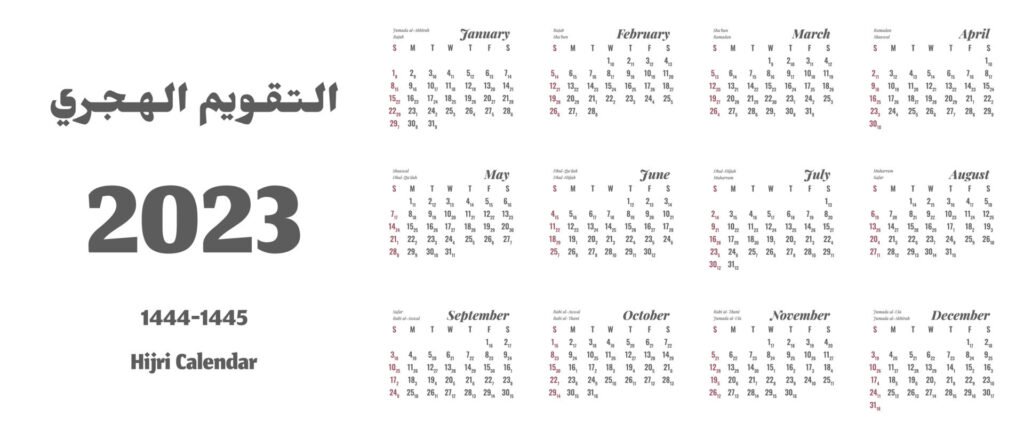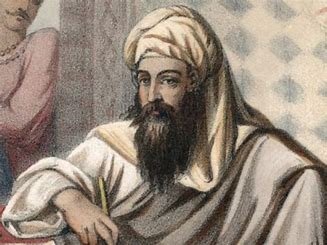Hijri calendar
The Hijri calendar, also known as the Islamic calendar, is a lunar calendar used by Muslims worldwide to determine the dates of religious events, including the holy month of Ramadan, Eid al-Fitr, and Hajj. It is based on the sighting of the new moon, and each year consists of 12 lunar months of 29 or 30 days, totaling 354 or 355 days.
The Hijri calendar was introduced in 622 CE when Prophet Muhammad migrated from Mecca to Medina, which is known as the Hijra in Islamic history. The first year of the Hijri calendar is marked as 1 AH and corresponds to 622 CE in the Gregorian calendar.
Unlike the Gregorian calendar, which is widely used for secular purposes worldwide, the Hijri calendar is mainly used for religious purposes and is an essential aspect of Muslim culture and tradition. It is used to determine the dates of religious festivals, observe fasts, and schedule pilgrimage to Mecca.

Solar Hijri calendar – Wikipedia
Prophet Muhammad, Messenger of God
Prophet Muhammad was the last prophet of Islam and is considered the final messenger of God in the Islamic faith. He was born in Mecca, Saudi Arabia, in 570 CE, and received his first revelation from Allah at the age of 40 while he was meditating in a cave on Mount Hira. The revelation continued for 23 years and is recorded in the holy book of Islam, the Quran.
Prophet Muhammad taught the fundamental principles of Islam, which include belief in one God, the importance of prayer, giving charity, fasting during the month of Ramadan, and making a pilgrimage to Mecca.
Prophet Muhammad’s teachings and actions are a source of inspiration and guidance for Muslims worldwide, and his life and legacy are highly revered in Islamic culture and tradition. He is recognized as a role model for his compassion, justice, and wisdom.

Science behind Hijri
The Hijri calendar is a lunar calendar based on the cycles of the moon. The moon’s cycle, which is approximately 29.5 days, forms the basis of the Hijri calendar. Each lunar month starts with the sighting of the new moon, and the Hijri year is 11 days shorter than the solar year, which is the basis of the Gregorian calendar used in the Western world.
The science behind the Hijri calendar involves the observation of the moon’s phases and the use of astronomical calculations to determine the start of each lunar month. The sighting of the new moon is traditionally done by trained observers, who look for the crescent moon after sunset on the 29th day of the current month. If the moon is not visible, the current month is considered to be 30 days long, and the new month starts the following day.
In summary, the science behind the Hijri calendar involves the observation of the moon’s phases and the use of astronomical calculations to determine the start of each lunar month, which forms the basis of the Islamic calendar. The moon phases play an important role in the determination of the Hijri calendar. If the new moon is not visible due to weather conditions or other factors, the previous month is extended to 30 days.
Months of Hijri calendar
Muharram
This is the first month of the Islamic calendar and is considered one of the four sacred months in which warfare is prohibited. It marks the beginning of the Islamic New Year and commemorates the Battle of Karbala.
Safar
This is the second month of the Islamic calendar and is considered an unlucky month by some Muslims. However, it is also a time for celebration and remembrance of the Prophet Muhammad’s migration from Mecca to Medina.
Rabi’ al-Awwal
This is the third month of the Islamic calendar and marks the birth of the Prophet Muhammad. It is celebrated by Muslims all over the world.
Rabi’ al-Thani
This is the fourth month of the Islamic calendar and is also known as Rabi’ al-Akhir. It is a time for reflection and spiritual renewal.
Jumada al-Awwal
This is the fifth month of the Islamic calendar and is a time for seeking knowledge and wisdom.
Jumada al-Thani
This is the sixth month of the Islamic calendar and is a time for seeking forgiveness and repentance.
Rajab
This is the seventh month of the Islamic calendar and is considered a sacred month. It is a time for spiritual cleansing and preparation for Ramadan.
Sha’ban
This is the eighth month of the Islamic calendar and is a time for reflection and preparation for Ramadan.
Ramadan
This is the ninth month of the Islamic calendar and is the most sacred month. It is a time for fasting, prayer, and charity.
Shawwal
This is the tenth month of the Islamic calendar and marks the end of Ramadan with the celebration of Eid al-Fitr.
Dhu al-Qidah
This is the eleventh month of the Islamic calendar and is considered one of the sacred months in which warfare is prohibited. It is a time for reflection and spiritual growth.
Dhu al-Hijjah
is the twelfth and final month of the Islamic calendar. It is considered to be a very sacred month for Muslims around the world, and is known as the month of Hajj.

Conclusion
Hijri is not only important to Muslims from a religious perspective but also from a cultural perspective. Many Muslim communities use the Hijri calendar to mark important events in their own cultural history, such as the birth of important figures or the founding of significant institutions.
Science is the base of Hijri as the main thing is the Moon. Important dates for Muslim religion depends on the moon as it directly linked with Hijri. It is used for religious observances: Hijri is used to determine the dates of important Islamic events and observances, such as Ramadan, Eid al-Fitr, and Hajj. These events are central to the practice of Islam and are observed by Muslims worldwide. It reflects the diversity of the Muslim world because the Hijri calendar is used by Muslims all over the world.



